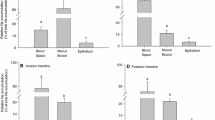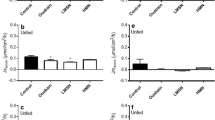Summary
Isolated gastric mucosa of the skate shows marked changes in acid secretory rate (J H ), electrical potential difference (PD), and transepithelial resistance (R) with changes in mucosal bathing solution composition and a constant serosal solution. Removal of the 350 mM urea usually present in the mucosal solution reduces acid secretory rate by 25%, while adding urea to 1 M has no significant effect. Complete removal of osmotic solutes (distilled water) inhibits secretion by 78%, isotonic urea (no salts) inhibits by 54%, while isotonic salts alone (no urea) gives control secretory rates. The changes in PD and R are consistent with acid secretory changes. Theory and experience with terrestrial organisms would not predict these changes. The most likely explanation is osmotic swelling and shrinking of the surface cells, and occlusion of the secretory tubules in the swollen condition. Since marine species never encounter hypo- or hyperosmotic conditions due to food ingestion, their surface cells may be water permeable, unlike the situation in terrestrial and fresh water animals.
Similar content being viewed by others
Abbreviations
- J H :
-
acid secretory rate per square centimetre tissue area
- OC :
-
oxyntic cell
- PBC :
-
pit border cell
- PD :
-
transepithelial electrical potential difference
- R :
-
transepithelial electrical resistance per square centimetre tissue area
- SEC :
-
Surface epithelial cell
References
Alonso D, Nigon K, Dorr I, Harris JB (1967) Energy sources for gastric acid secretion: substrates. Am J Physiol 212:922–1000
Blankemeyer JT, Kidder GW III (1986) Electrochromic dyes for visualization and assessment of intracellular potential in the gastric mucosa of Raja erinacea. Bull Mt Desert Isl Biol Lab 26:67–69
Bressler EH, Wendt RP, Mason EA (1971) Steady-state sieving across membranes. Science 172:878–879
Durben RP, Heinz E (1958) Electromotive chloride transport and gastric acid secretion in frog. J Gen Physiol 41:1035–1047
Hogben CAM (1959) The electrophysiology of the elasmobranch stomach. Science 129:1224–1225
Kidder GW III (1973) Electrical measurements in epithelial tissues: Theory and practice. J Biol Phys 1:143–174
Kidder GW III (1976) Effects of oxygen and carbon dioxide on the dogfish gastric mucosa in vitro. Am J Physiol 231:1240–1245
Kidder GW III (1990) Cytochrome-mediated electron transport in H+-secreting gastric cells. Ann N Y Acad Sci 574:219–232
Kidder GW III, Elrod MG (1984) Voltage clamping changes resistance and current-voltage plot of frog gastric mucosa. Am J Physiol 246:G574-G579
Kidder GW III, Kidder EL (1983) Electrical and secretory responses of skate gastric mucosa. Bull Mt Desert Isl Biol Lab 23:39–41
Rehm WS (1967) Ion permeability and electrical resistance of the frog's gastric mucosa. Fed Proc 26:1303–1313
Author information
Authors and Affiliations
Rights and permissions
About this article
Cite this article
Kidder, G.W. Effects of luminal osmolarity on gastric acid secretion in the little skate, Raja erinacea . J Comp Physiol B 161, 323–326 (1991). https://doi.org/10.1007/BF00262315
Accepted:
Issue Date:
DOI: https://doi.org/10.1007/BF00262315




